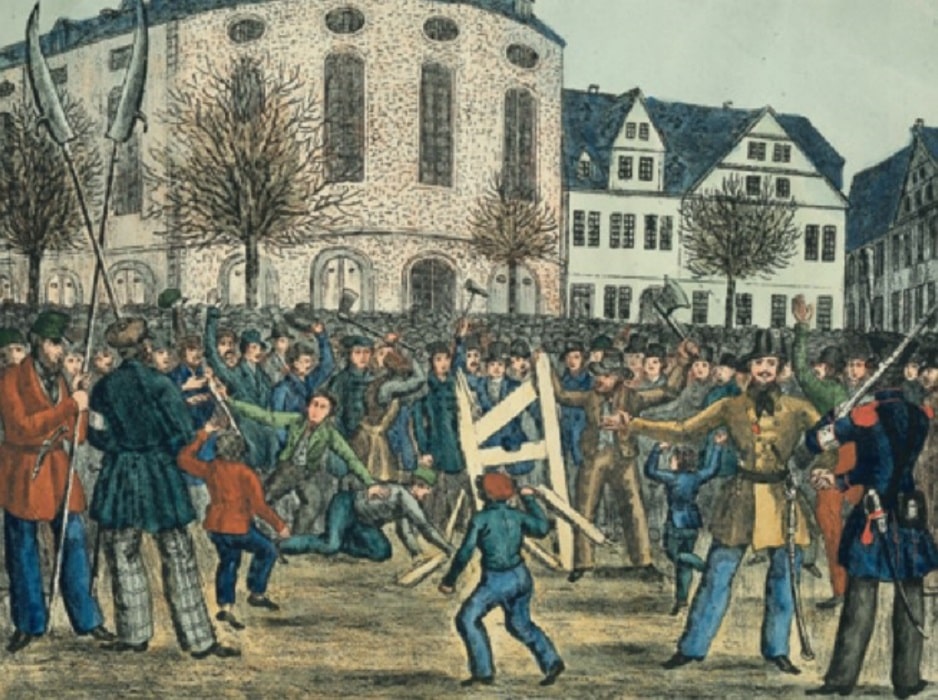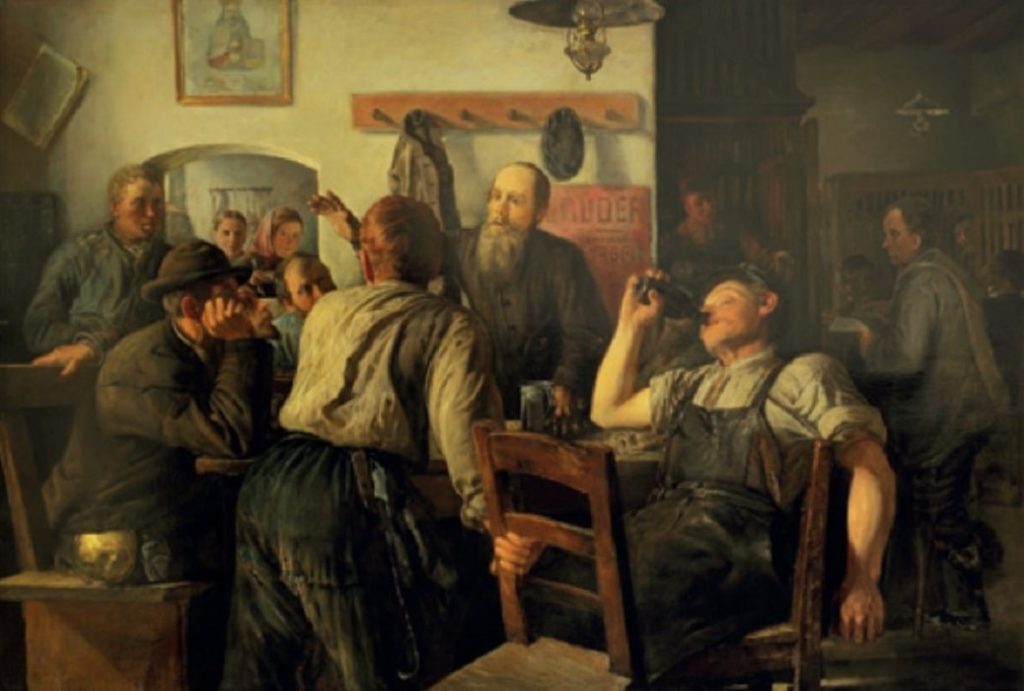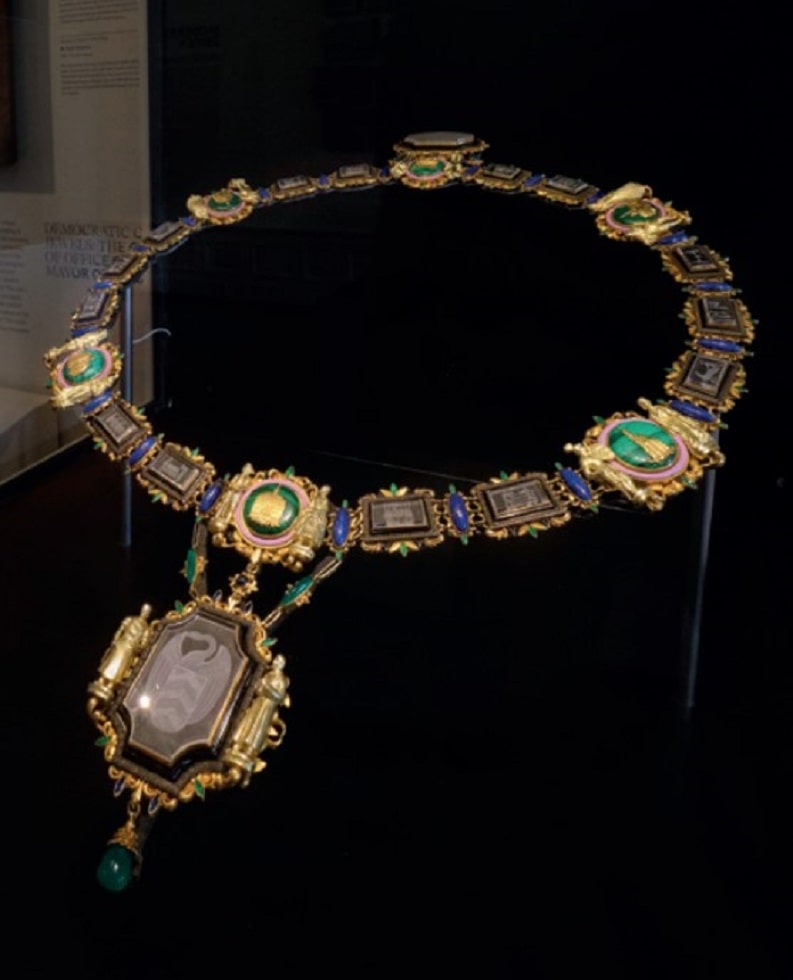Art, Trade and Society in Hanau between the Pre-March and the Post-War Era
No period before saw such great changes and disruptions in Germany and the whole world as the century between the 1848 Revolution and the reconstruction after the Second World War.
Fig. above: Chain of office of the Lord Mayor of Hanau, design Hugo Leven, execution: teacher of the drawing academy, 1927, gold, fine silver, malachite cabochons, rock crystals, lapis lazuli, chrysoprase, black onyx, sapphire, rock crystal, cut, enamelled, chased (© Detlef Sundermann).
As if through a burning glass, the phenomena of this period can be observed in Hanau’s history. Whether artistic styles, modern building, wars and crises, the struggle for participation or the personal networks in the city – the exhibition of the Hanau Historical Museum Schloss Philippsruhe shows the entire panorama of the city’s development over a century that has shaped it to this day.
It describes the democratic and liberal upswings in the city as well as its setbacks. It also shows Hanau’s development into an industrialised commercial city with its innovations and shortcomings. The focus is on paintings, sculptures and decorative art objects of international standing. They reveal the outstanding artistic quality of Hanau’s artists such as August Gaul, Hugo Leven or Wilhelm Wagenfeld and the Hanau Drawing Academy.
The permanent exhibition, however, illustrates one characteristic of this period in particular: people’s turmoil between rapid belief in progress and flight into supposed idylls.

MASTERS AND MAKERS
THE MODERN HANAU SOCIETY
Who were the people involved in the city’s modernisation processes? How were they connected to each other or how did they face each other? Looking at the people and networks behind the major urban development processes is the focus here – interactive media stations invite visitors to participate!
PARTICIPATION AND COUNTER-WORLDS
THE QUEST FOR VOICE AND EQUALITY
Gymnasts, workers, religious minorities and women – they all strove for participation; participation in the social, cultural, economic and political decision-making processes and spaces. The century between 1848 and 1946 was decisively marked by the disputes and negotiation processes around this striving.

REFORMS AND GRIEVANCES
LIVING AND WORKING ENVIRONMENTS IN HANAU
In the second half of the 19th century – also thanks to the annexation of Hanau by Prussia – there was a surge of modernisation in many areas of urban life. At the same time, industrialisation took hold in Hanau’s trades. This also meant poorer working and living conditions for the industrial workers who flocked to Hanau. Important social solutions were needed here.
MOVEMENT AND INTERCONNECTEDNESS
NETWORKS IN HESSE, GERMANY AND EUROPE
With the invention of the railway, the world grew closer together. Distances could be bridged faster and easier. This increase in mobility was accompanied by the European expansionism, which was characterised by a hunger for industry and raw materials. This opening of the world view from a Eurocentric perspective was also reflected in art.
CRISES AND CULTURE
LEISURE, ART AND FATES THROUGH WAR AND TIMES OF NEED
Between 1848 and 1946 there were two revolutions, two world wars, economic crises and currency reforms and, last but not least, the National Socialist era with the Holocaust. Times of war and hardship alternated with periods of economic and artistic prosperity and human abysses. Throughout all these periods, many continuities, but also serious breaks in people’s biographies and in their artistic and social forms of expression can be observed.

PLANNING AND GROWING
THE MODERN HANAU TOWNSCAPE
Since the founding of Hanau’s Neustadt in 1597, the cityscape has never changed as rapidly as in the 19th and 20th centuries. Industrialisation and the accompanying urbanisation processes led to housing shortages, poverty, but also to important urban renewal thrusts, a modern infrastructure from energy to health care, educational and cultural locations, just like military barracks and new transport routes.
WHERE?
Hanau Historical Museum Schloss Philippsruhe
Philippsruher Allee 45
63454 Hanau
WHEN?
Sunday, 1 March 2020 until Monday, 30 December 2024
COST?
Adults 5,- €, Reduced/Groups 4,- €
Children and youths up to 18 years free of charge






